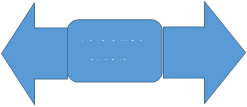
THE LEVELS OF GRAMMATICAL ORGANIZATION .
Rajabova Kamilla Zavkiddinovna:
a sophomore of Uzbek State World
Languages university. UzSWLU.
Academic adviser: a dean of the faculty
of translation as well as a senior lecturer:
Omonov P.X.
Annotation: the levels of grammatical organization are scrutinized in this scientific paper and their connection with the whole grammatical organization is illustrated .
Key words: positionally – directive , inventorial , communicatively – styled levels ; pyramid of generalization ; correlation ; correctivity ; electiveness ; agglutinative , incorporating , root , synthetical, analytical types.
Grammar is the system of contact connections both of morphemes within the word and sentences within the speech complexes.
Grammar , therefore , is limited by the spheres of morphemes , words , sentences and speech complexes .
The system of contact connections is of expanding character . Everything depends on the level of grammatical organization where the ties of connection are viewed from. These levels are :
1) positionally – directive ( or code ) ;
2) inventorial ( or standard – language ) ;
3) communicatively – styled ( or individual – speech ) .
These levels are inseparably interconnected creating a certain kind of a three rank pyramid of generalization . Its bottom is occupied by the first level which is by far the deepest being logical by its nature . Due to its ciphering character this level is common to all who speak this language .
The second rank of the pyramid belongs to the corresponding second level of grammatical abstraction. It is mutually tied together with the first because any notion requires some language matter for its realization .
The top of the pyramid is formed by the third level of abstraction which is based on delivery of information . Being individual this level presupposes the act of communication .
Each level has its formalized meaning :
1) the first – correlation;
2) the second – correctivity ;
3) the third - electiveness .
Correlation establishes the line of identification between the thinking person and the outer world objects irrespective of the concrete language the person speaks .
Correctivity gives the grammatical regulation to the line of identification correcting it in a purely national way of contacts.
Electiveness dictates the choice of the most adequate grammatical form within the sphere of the synonymous ones .
Each basic meaning has the formalized sphere of its realization and the formalized structure of its representation .
Formalized sphere as well as formalized structure is vital in language system. They are connected by dint of the main principles of language structure. It should be stated that tree levels of grammatical organization is the skeleton of the language in general.
It is worth analizing of formalized sphere and formalized structure by dint of diagramm below:


 |
![]() correlation correctivity
correlation correctivity

electiveness
 |
|||
 |
|||



 |
correlation correctivity
 |
electiveness
Positional direction determines the centripetal or centrifugal form of identification , each of which has its own set of features.
Centripety is characterized by :
1) monocentrism ;
2) the meaning of being ;
3) relative nonterminativeness .
Centrifugalness is characterized by :
1) bicentrism ;
2) the meaning of possession traced in its direct or indirect quality ;
3) terminativeness .
Grammatical types embrace the grammatical inventory of each language . This level charges the positional direction by the required grammatical structure. The list of the language grammatical types not being long includes only five of them :
· agglutinative
· incorporating
· root
· synthetical
· analytical types
Agglutinative type – words may contain different morphemes to determine their meanings , but all of these morphemes remain in every aspect unchanged after their unions .
Incorporation is the phenomenon by which a grammatical category , such as a verb , forms a compound with its direct object or adverbial modifier , while retaining its original syntactic function .
Root is the base part of a word less any prefixes and suffixes .
Synthetical type expresses syntactic relationships within a sentence .
Analytic type conveys relationships between words in sentences by way of helper words ( particles , prepositions , etc. ) and word order , as opposed to utilizing inflections ( changing the form of a word to convey its role in the sentence ) .
Grammatical synonymy as the sphere of realization of electiveness is based on the selected delivery of information .
Conclusion: In their functioning the levels of grammatical organization are based on principles of integration , the investigation of which is considered to be the widest and therefore the most complicated problem of modern linguistics .
Each person estimates the object arbitrarily . That is why the realization of the inventorial level becomes possible due to the individual usage of forms within the sphere of grammatical synonymy . The latter being an objective phenomenon is individual in its concrete usage by every member of the same linguistic community of people .
The list of used literature: .
1 . Koshevaya I . G . The theory of English grammar . M. , 1982 .
2. Vorontsova G . N . The summary of English grammar. M. , 1956 .
3. Poutsma P . H . Grammar of Late Modern English ., 1926 .
4. Chafe V . Structures of English . N . Y . ., 1963 .
5. Sweet H . Language . N . Y . , 1931 .
6.Bonk N . A . , Lukyanova N . A . , Pamukhina L . G . , English language . B. , 2001.
7. Kachalova K . N . , Israilevich E . E . English grammar ., T., 2015.
Материалы на данной страницы взяты из открытых источников либо размещены пользователем в соответствии с договором-офертой сайта. Вы можете сообщить о нарушении.